Edward Willett's Blog, page 20
November 6, 2016
A review of Line Dance. Apparently I have a sense of humour. Who knew?
 Here’s the first review I’ve seen of Line Dance, the collection of poems that resulted from…well, I’ll let the reviewer explain, because I’m tired of typing various versions of this:
Here’s the first review I’ve seen of Line Dance, the collection of poems that resulted from…well, I’ll let the reviewer explain, because I’m tired of typing various versions of this:
Each weekday during Poetry Month in April, Hill [ Poet Laureate Gerald Hill] e-mailed SK Writers’ Guild members a pair of first lines he’d selected from SK poetry books and invited folks to respond with poems of their own. Some, like professionals Brenda Schmidt and Ed Willett, sent poems every day. In the end, almost 500 pieces were submitted, and SK writing veteran-turned publisher, Byrna Barclay, bound what editor Hill deemed the best into a handsome package, featuring Saskatchewanian David Thauberger’s art on the cover.
I have six poems in the anthology, drawn from those I also posted online (start here), ably edited for length and other improvement. I get a shoutout in the review:
Ed Willett’s penned sci-fi/fantasy poems and showcases his sense of humour (“Please don’t think we’re prejudiced/against vampires” and “my husband hasn’t held a steady job/since he became a werewolf”), as does the ever-clever and perceptive Brenda Schmidt, ie: “I’ve always known the backroad/is the road less graveled”.
There’ll be a formal launch of the anthology at McNally Robinson Booksellers in Saskatoon on the evening of November 24. There’ll be brief readings and, I fear, actual line-dancing. Come out if you’re nearby and interested!
October 31, 2016
Singing with the Prairie Chamber Choir
This year I’ve joined the Prairie Chamber Choir, directed by Melissa Morgan. I’ve missed singing with a high-quality choir, and this one definitely is that. We’re working toward our Christmas concert on December 18, but we did have a mini-concert recently, singing three songs by Winnipeg composer Sid Robinovitch in the Classical Showcase of Break Out West 2016 (a.k.a. the Western Canadian Music Awards). And here’s a video!
The first piece is part of the set of songs for which Sid was nominated, although, alas, he didn’t win.
You’ll find me second from the left (audience left, not stage left) on the back row.
October 30, 2016
What does writing success mean to me?
The Flames of Nevyana blog tour has wrapped up! The final two stops of note were this long review of the book from Jorie Loves a Story (too long and detailed to easily excerpt, so read it in situ), and an interview from Melissa Yaun-Innes’s blog, of which here’s a large chunk (Just in time for Hallowe’en, it’s headlined, “Crawl into Edward Willett’s mind”)…
Q. What does writing success mean to you? Awards, money, readers, all of the above?
To me, what feels like success varies depending on the day of the week.
Well, not quite, but almost.
When I receive an award (and I’ve received a few—a Saskatchewan Book Award for my YA fantasy Spirit Singer [Tyche Books]; an Aurora Award [the top award for Canadian science fiction and fantasy] for my science fiction novel Marseguro [DAW Books]; even a City of Regina Heritage Award for Historic Walks of Regina and Moose Jaw [Red Deer Press]), then naturally it feels for that moment that awards are what writing success is all about.
When I sign a contract that means I will soon be receiving money with which I can a) pay the water bill; b) get the car serviced; c) pay off Visa, then money certainly seems like the best measure of writing success. Since I’m a full-time writer with no other source of income, this is certainly one kind of success I’m constantly seeking.
When I find a glowing review of one of my books, particularly if it appears in a prominent publication whose reviews are influential, then the getting of good reviews seems to me the perfect measure of writing success. In the immortal words of Sally Field receiving an Academy Award, “You like me, you really like me!”
When I write a sentence or a scene or even, if I’m lucky, a whole chapter with which I am utterly and completely satisfied, then that seems like a good measure of writing success. I have pleased my most persnickety critic, myself. (To paraphrase Sally Field, “I like me, I really like me!”)
But thinking long and hard on this question over the years, particularly when doubts as to the wisdom of my chosen career arise, I’ve come to the conclusion that what meaningfully defines writing success is readers. Writing is, ultimately, a form of communication. As writers, we strive to transplant the ideas, characters, situations, and entire worlds we imagine into the imaginations of other people. It’s a monumental task. When it works, your writing is successful —it’s that simple, and that hard.
Alas, we don’t always know when we’ve succeeded. Most readers never bother to reach out an author whose work has entertained, enlightened, challenged, or changed them. If you become a bestseller you can assume you’ve reached a lot of readers, so perhaps that is a measure of success, but the truth is, every writer is successful whenever he or she manages to bridge that gap between his or her mind and the readers, to open up a new world of imagination. I like awards, I like money, I like reviews, and I’d love to be a bestseller. But ultimately, I think every book I write is a success—and therefore I am a success—so long as somewhere there is a reader who loves it.
October 27, 2016
A Q&A at Chapter by Chapter
Yesterday’s stop in the Flames of Nevyana blog tour was at the host site, Chapter by Chapter, and featured a Q&A (plus an excerpt and link to the giveaway!)
Describe your book in 140 characters or less (like a Tweet)
Three teenagers must overcome their mutual mistrust to save their land when the sacred secrets of Blue Fire are stolen and turned to evil.
What was your inspiration for writing this book? Was it in a dream? A thought while taking a walk?
I was driving from my home town of Regina, Saskatchewan, to Meadow Lake, about 500 kilometres further north, to do a reading at the library. Whenever I’m on my own in the car on a long trip I do a lot of thinking about writing, and on this occasion I deliberately set myself the task of coming up with a new idea for a YA fantasy novel. I got to thinking about Arthur C. Clarke’s famous dictum that “Any sufficiently advanced technology is indistinguishable from magic,” and that led me to think that our mastery of electricity would certainly seem like magic to someone from the Middle Ages. From there it was a short leap to the idea of a magic system based on electricity. In my book, Blue Fire is still magic, and is controlled through magical means, but it’s clearly electricity, too. With that idea in mind, I began my usual process of asking myself questions about the world: how would Blue Fire be used? How did the people learn to harness it? Who might be harmed or benefit from it? By the time I got to Meadow Lake, I had the broad outlines of the story sketched out in my head. I think I even talked about it in my presentation that night.
Tell us about the main character(s).
There are three viewpoint characters in flames of Nevyana, each a member of one of the three very different cultures within the Kingdom of Nevyana. They’re all of an age: about sixteen. Petra is a Priest-Apprentice of Vekrin, God of the Earth, one of the three surviving Gods of Nevyana. He’s also the son of the First Keeper of the Temple of Primaxis—the top priest in the Kingdom. Amlinn is the granddaughter of the leader of Clan Therra of the Freefolk, nomadic people who travel the wilderness from City to City, and a devout follower of Arrica, Goddess of the Sun. The people of Vekrin and the people of Arrica mistrust each other, the former seeing the latter as nothing more than lazy, shiftless vagabonds, the latter seeing the former as dull and conceited. And then there’s Jin. Jin is a Nightdweller. They follow Ell, Goddess of the Moon, and long ago she changed them into furred, almost feline, nocturnal dwellers who cannot bear the light of day—and who for centuries have hunted and killed any of the followers of Vekrin or Arrica they find in their forests at night. Because of the threat of the Nightdwellers, Petra and the other followers of Vekrin lock themselves behind city walls at night. Only the followers of Arrica, Amlinn’s people, dare to stay in the forest at night, and only because they have the magic of the Fence, a barrier of Blue Fire that Nightdwellers cannot pass. It is not infallible, however, and when she was little, Nightdwellers killed Amlinn’s parents. Petra, Arrica, and Jin are the most unlikely of allies…and yet allies they become.
Do you have a favorite quote or specific part in the book that you really love?
I like this quote, which is central to the book: “The fact the Gods have not been heard from for five hundred years does not prove they will not return tomorrow. But it seems a thin thread on which to hang the living of your life, and little reason to accept death, suffering, and the slow decline of our civilization.”
Was there a specific part in the book that you had an especially difficult time writing? If so, why?
Each of the characters suffers, at one time or another, what might be called a crisis of faith, as they question the will, and even the existence, of the Gods each of them has sworn to follow. Since I’m the son of a preacher and the finest people I know are people of faith, I found writing scenes in which characters renounce their faith a little uncomfortable. However, I hasten to add that the Gods of Nevyana have no counterparts in the real world and the characters’ renouncing of their faith in them is totally the right thing to do, and no reflection on anyone’s faith in the real world.
What sort of projects do you have going on right now. Any new books coming out?
I’m currently working on two non-fiction projects—a book about Saskatchewan politics in the 1980s and a history of a local engineering firm. On the fiction side, I’m about to plunge into revisions for my next science fiction novel, The Cityborn, which will be coming out from DAW Books in July 2017. After that, I’ll be writing the first two books in a new fantasy series I’ve sold to DAW, tentatively titled Worldshapers. I’m also working toward bringing out an illustrated collection of science fiction/fantasy/horror poetry I wrote earlier this year. I have a middle-grade fantasy/horror proposal with my agent, Ethan Ellenberg, and feelers out for some other novels. Never a dull moment!
October 24, 2016
Flames of Nevyana “an awesome and fun book”
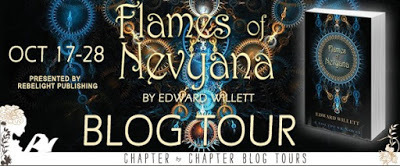
The Flames of Nevyana book tour continues with this review from Lori’s Little House of Reviews:
“I have to say I really loved this book a whole lot, I feel in love with all three of these individuals…I really loved all three of their relationships. I loved that they were suppose to be enemies but became such friends.
“I really loved the ending…I loved that all three of them stood up for what they believed in…Even the bad guy of the story you could understand why he did what he did, even though he went about it the wrong way. It was such an awesome and fun book to read.”
“Awesome and fun.” I’ll take that. :)
October 22, 2016
A long interview with me from Books Chatter
The Flames of Nevyan a blog tour continued today with this long interview at Books Chatter. I had fun answering these questions.
A very warm welcome to Edward Willett (a.k.a. E.C. Blake); thank you for joining us on BooksChatter! What was the inspiration for Flames of Nevyana?
“I was driving from my home town of Regina, Saskatchewan, to Meadow Lake, about 500 kilometres further north, to do a reading at the library. Whenever I’m on my own in the car on a long trip I do a lot of thinking about writing, and on this occasion I deliberately set myself the task of coming up with a new idea for a YA fantasy novel.
I got to thinking about Arthur C. Clarke’s famous dictum that “Any sufficiently advanced technology is indistinguishable from magic,” and that led me to think that our mastery of electricity would certainly seem like magic to someone from the Middle Ages. From there it was a short leap to the idea of a magic system based on electricity. In my book, Blue Fire is still magic, and is controlled through magical means, but it’s clearly electricity, too.
With that idea in mind, I began my usual process of asking myself questions about the world: how would Blue Fire be used? How did the people learn to harness it? Who might be harmed or benefit from it? By the time I got to Meadow Lake, I had the broad outlines of the story sketched out in my head. I think I even talked about it in my presentation that night.”
How much of yourself is reflected in this book, and how?
“I figure I’m reflected in all my books. I can’t help but be. The only person I really know is myself, and so all my characters are, in some way, a piece of myself. Even the ones who appear to have nothing in common with me at all (and one of the characters in Flames of Nevyana is a bipedal feline) are still constructed using my own sense of how human beings think.”
A bipedal feline… uhm… that sounds like a dangerous thing… I hope he doesn’t also have opposable thumbs! ;-)
The first thing that draws me to a book is its cover. Can you tell us about your cover for Flames of Nevyana – why you chose that concept and who the artist is.
“I love the cover, but I didn’t have anything to do with it. My publisher, Rebelight, chose the artist and presumably suggested what the cover should look like.
That said, I like the intricate suggestion of gears within gears, the kind of fractal nature of the image, that sense that tiny changes can have major implications. That ties in well with the plot. The somewhat mechanical nature of the image also ties in with the magic system. Blue Fire, the central magic of the story, is essentially electricity, even if its produced and controlled through magical means, and I think the cover captures that.”
Why should we read Flames of Nevyana and what sets it apart from the rest? What makes your book unique?
“Rebelight is calling this a “voltpunk” novel, because the magic is based on electricity. That makes it unique, because as far as I know, that term hasn’t been used before.
As for why you should read this book? Because it’s a great story, full of adventure and magic and even romance. Because it has three unique young people who are each complex and quirky and must learn how to work together despite all the aspects of their society that are trying to drive them apart. Because the world and the magic system are both unique. And because you’ll have a wonderful time reading it.”
Can you tell us something quirky about Flames of Nevyana, its story and characters?
“The main reason that the Nightdwellers are bipedal felines is that I love cats. My science fiction novel Terra Insegura (DAW Books) has a race of genetically modified humans, the Kimonomimi, who are also essentially bipedal cats. One of the first short stories I ever wrote had an alien in it who is feline in nature. I’m always happy when I can work anything cat-related into a story. I wish reincarnation were real so I could come back as a cat.
As I write this, my cat (Shadowpaw, a black Siberian) is stretched out on a chair in the living room looking adorable. I think I’d better go rub his tummy.”
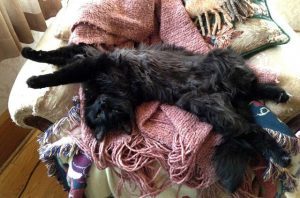 Awww! Yes, you better! (we kind of are rather partial to cats as well… we currently have seven little monsters…)
Awww! Yes, you better! (we kind of are rather partial to cats as well… we currently have seven little monsters…)
Hello Shadowpaw! Lots of head scratches from us as well :-D
Who would you recommend Flames of Nevyana to and what should readers be aware of (any warnings or disclaimers)?
“I’d recommend Flames of Nevyana to anyone who loves action-and-magic-filled young adult fantasy: readers, say, 12 and above. Adults will enjoy it, too.”
If you could / wished to turn Flames of Nevyana into a movie, who would be your dream team?
“I’d give it to the Duffer Brothers, who created Stranger Things, and Millie Bobby Brown, who played Eleven in that series, could play Amlinn (in a year or two).
It should be filmed in a valley in the Canadian Rockies.
Music by John Williams. Petra could be played by Asa Butterfield. Jin would probably be computer-generated.”
What do you like to write and read about? Do you stick to a particular genre or do you like to explore different ones?
“I’m the award-winning author of more than 50 books of fantasy, science fiction, and non-fiction for all readers, so I write a lot of different stuff.
I’ve also written plays, short stories, a weekly newspaper column, local history books, and more. But there’s no question my main love is science fiction and fantasy.
My first short story, written when I was 11, was called “Kastra Glazz: Hypership Test Pilot.” I wrote two fantasy novels and one adventure novel in high school. My first published novel (Soulworm) was modern-day fantasy, while my second (The Dark Unicorn) was a more traditional medieval-world fantasy.
But then I turned to science fiction with Andy Nebula: Interstellar Rock Star. Then it was back to fantasy (Spirit Singer), followed by three science fiction novels for my New York publisher, DAW Books (Lost in Translation, Marseguro—which won the 2009 Aurora Award for best Canadian science fiction novel in English—and Terra Insegura, short-listed for the same award the following year).
I switched to fantasy for DAW with Magebane (written as Lee Arthur Chane), and then my just-completed trilogy The Masks of Aygrima, Masks, Shadows, and Faces (written as E.C. Blake).
My other big project recently has been a just-completed five-book young adult fantasy series called The Shards of Excalibur (Song of the Sword, Twist of the Blade, Lake in the Clouds, Cave Beneath the Sea, Door into Faerie), about a modern-day teenage girl, Ariane, who discovers she’s heir to the power of the Lady of the Lake, and must find the scattered pieces of Arthur’s legendary sword (with the help of her friend, Wally), before Merlin can—Merlin is disguised in our modern age as a Steve Jobs, Bill Gates-style computer magnate. That series was published by the respected Canadian literary publisher Coteau Books.
So I guess you could say my first choice of genres is always either science fiction or fantasy, but I go back and forth between the two with regularity. And, yep, that’s what I love to read, too. I don’t think you CAN write science fiction and fantasy without reading them voraciously.”
What is your writing process?
“I get the idea, craft a fairly detailed synopsis, and then tend to leave that behind pretty quickly once I’m actually writing, as one paragraph flows into the next and characters begin asserting themselves. I often find myself having to completely replot halfway through the book since the original synopsis no longer works.
I write fast, when things are going well. I wrote Door Into Faerie, the fifth book in The Shards of Excalibur series, in 2 ½ weeks—it’s 60,000 words. I wrote Shadows, Book 2 in The Masks of Aygrima trilogy, in a month—that’s 105,000 words. Of course, there’s a lot of revision after that, first my own polishing, and then the revisions suggested/required by my editor. But first drafts pop out pretty fast.
I tend to write out of my home office, in a coffee shop or (ahem) bar. Sometimes the background noise can be too distracting and I have to put on headphones to block it out, but a general hubbub of voices doesn’t bother me, and I find there are fewer distractions when I’m out of my office than when I’m in it.”
What is in store next?
“My next non-fiction book to appear will be Government House, Regina, Saskatchewan: An Illustrated History, which is just what it sounds like.
My next novel will be The Cityborn, my eighth for DAW Books in New York. It’s a science fiction novel set in a strange, hierarchical city that straddles a canyon choked with the garbage dumped from the city over centuries. A girl from the very top of city finds herself thrown into the underworld of the garbage heap, and with a young man who has grown up there must uncover the strange, terrifying secrets that connect and threaten them.
After that, I’ll be writing the first book in the Worldshapers fantasy series, an open-ended series for DAW. They’ve bought the first two books but I hope there’ll be many more. I also hope to have an illustrated poetry book out in the not-too distant future, and there are a few things I’m looking at self-publishing. Never a dull moment!
Right now, there are no plans to write a sequel to Flames of Nevyana, which is pretty self-contained…but you never know.”
And as a final quirky thing, to get to know you a little bit better… do you have a pet or something that is special to you that you could share with us?
 “Something special to me? That would definitely be my daughter, Alice.
“Something special to me? That would definitely be my daughter, Alice.
In addition to writing, I also perform—I’m an actor and singer, sometimes just for fun, sometimes professionally. Last spring Alice and I had the chance to be in a show together: Regina Lyric Musical Theatre’s production of The Addams Family Musical. I played Lurch and she played one of the Addams ancestors. Which explains the photo! :-)”
October 21, 2016
The Space-Time Continuum: Frankenstein, the first science fiction novel
This is my Space-Time Continuum column for the latest issue of Freelance, the magazine of the Saskatchewan Writers Guild. It’s a modified version of a column I wrote ages ago as one of my newspaper science columns. It seemed appropriate to bring that old column back to life…bwah-ha-ha!
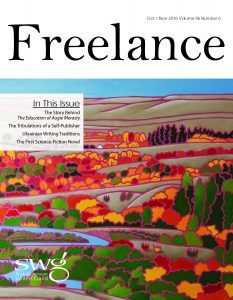 As I write this, it’s about three weeks until Hallowe’en, a time when people’s thoughts turn to monsters. While in this modern age there are a great many more monsters to choose from than there used to be, there’s no doubt that one of the most popular (which is an odd thing for a monster to be, perhaps, but still) is the one created by Dr. Victor Frankenstein, assembled from pieces harvested from multiple corpses and reanimated through the miracle of electricity.
As I write this, it’s about three weeks until Hallowe’en, a time when people’s thoughts turn to monsters. While in this modern age there are a great many more monsters to choose from than there used to be, there’s no doubt that one of the most popular (which is an odd thing for a monster to be, perhaps, but still) is the one created by Dr. Victor Frankenstein, assembled from pieces harvested from multiple corpses and reanimated through the miracle of electricity.
It’s probably a safe bet that those who choose to dress themselves as Frankenstein’s monster on Hallowe’en don’t do so to honour the birth of science fiction—and a new way of looking at the world—but the novel that gave us the monster, Frankenstein, or, The Modern Prometheus, marked both.
At first glance, Frankenstein seems like just another Gothic novel, full of dank castles, wandering spirits, mysterious, brooding characters, barren moors, and strange doings by midnight.
But Gothic novels relied on superstition and magic, and Mary Shelley, a bright, thoroughly modern 18-year-old, had no time for such things. She saw vast changes being wrought in society through the revolutionary idea that the world could be understood as the product of natural forces, not supernatural ones, and that those forces could be harnessed and used. Mary became the first writer to use science as the springboard to a tale of imagination, and in so doing, not only launched science fiction, but also ignited a debate on science’s role in society that continues to this day.
Mary Shelley was born in England in 1797, the daughter of philosopher William Godwin and author and feminist Mary Wollstonecraft Godwin. She met the poet Percy Bysshe Shelley in 1814, and two months later, left England with him. They were married in 1816, after the death of his first wife. Before they were married, she had a son by him, who died in infancy.
The year they married, Mary, Percy and another writer spent a rainy summer at Lord Byron’s house on Lake Geneva. They passed the time by reading ghost stories; Lord Byron suggested they each attempt to write one. At first, Mary couldn’t come up with an idea; but then, one night, the conversation turned to the nature of life, and whether it might someday be possible to return life to dead creatures, possibly using electricity, which had been shown to make an amputated frog’s leg twitch.
That night, Mary dreamed: “I saw the pale student of unhallowed arts kneeling beside the thing he had put together. I saw the hideous phantasm of a man stretched out, and then, on the working of some powerful engine, show signs of life, and stir with an uneasy, half-vital motion…”
The next day she began writing Frankenstein. Published anonymously on March 11, 1818, it became a huge success, and hasn’t been out of the public consciousness since.
The story, in brief: a Captain Walton writes to his sister from his ship, on an expedition to the Arctic. The crew saw a monstrous creature driving a sledge across the ice; the next day they rescued a man, Victor Frankenstein, who told Walton a terrible tale of his successful quest to create life, and the horror he felt when he succeeded.
Within Victor’s narrative are several chapters from the viewpoint of the creature itself, describing how he was driven out and betrayed by his creator. Victor tells Walton he promised to create a bride for the monster, but couldn’t bring himself to fulfill his promise. In revenge, the creature killed several people dear to Victor, who has been pursuing the creature ever since.
Victor dies; the creature appears on the ice-bound ship and, torn by grief, remorse and self-loathing, swears he will kill himself. He disappears into the cold and darkness.
At the time Mary wrote, chemistry, physics and physiology were advancing rapidly; railroads were being built, gaslights illuminated factories and would soon light cities, a steamship would soon cross the Atlantic. In the dawn of the scientific age, anything seemed possible: as the chemistry professor Waldman says in Frankenstein, modern researchers “ascend into the heavens: they have discovered how the blood circulates, and the nature of the air that we breathe. They have acquired new and almost unlimited powers; they can command the thunders of heaven, mimic the earthquake, and even mock the invisible world with its shadows.” By contrast, the magicians and alchemists of the past “promised impossibilities, and achieved nothing.”
But in Frankenstein, the promise of scientific advancement was balanced against its cost. Today, we do bring people back from the dead, shocking their fibrillating hearts with electricity. We alter life through genetic engineering. But in the era of nuclear weapons and global environmental devastation, we also know that scientific advancement is a two-edged sword. Our creations can turn on us…just as Victor Frankenstein’s did.
Forget Boris Karloff with bolts attached to his neck, and read Mary Shelley’s Frankenstein, or The Modern Prometheus, the world’s first science fiction novel. As is usally the case, the book is better.
Flames of Nevyana “a wonderful YA read”
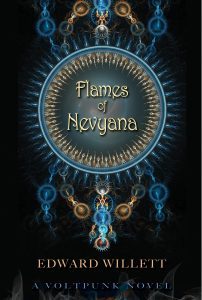 The Flames of Nevyana blog tour continues with a review from Book Horde.
The Flames of Nevyana blog tour continues with a review from Book Horde.
“Great world-building, a fantasy feel with an SF twist, admirable characters, and the themes of courage and truth above all make Flames of Nevyana a wonderful YA read. I know my teen will really enjoy it.”
October 20, 2016
Hear me read a Hallowe’eny poem
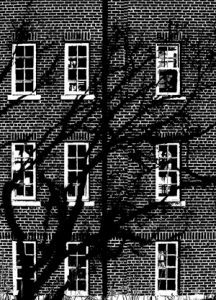 Looking for something both poetic and Hallowe’eny? (And who isn’t?) The Science Fiction Poetry Association has a page of audio files of SFPA members reading their Hallowe’en-related poems–and it includes a file of me reading “He Really Should Have Written,” one of the poems I wrote for Poet Laureate Gerald Hill’s “First Lines” project back in April. A shorter version of this poem appears in the new First Lines anthology published by Burton House Books, which launches November 24 at McNally Robinson in Saskatoon (I’ll remind you, don’t worry.)
Looking for something both poetic and Hallowe’eny? (And who isn’t?) The Science Fiction Poetry Association has a page of audio files of SFPA members reading their Hallowe’en-related poems–and it includes a file of me reading “He Really Should Have Written,” one of the poems I wrote for Poet Laureate Gerald Hill’s “First Lines” project back in April. A shorter version of this poem appears in the new First Lines anthology published by Burton House Books, which launches November 24 at McNally Robinson in Saskatoon (I’ll remind you, don’t worry.)
Here’s my audio file, although I urge you to over to SFPA and listen to them all!
The image above is a photo I took (and then manipulated, obviously), which has the cheery name “The Creeping Darkness.” It’s actually a very ordinary apartment building just down the street from where we used to lie in Regina.
http://edwardwillett.com/wp-content/uploads//2016/10/He-Really-Should-Have-Written_01.mp3
Answering a question about how I write characters
The Flames of Nevyana blog tour continues. Today, I have this guest post at The Avid Reader about how I write characters…
Do the characters all come to you at the same time or do some of them come to you as you write?
Characters are the heart and soul of fiction: just as excellent acting can redeem even the ugliest set in a theatrical production, so excellent characters can go a long way toward overcoming deficiencies in an imaginary world. On the other hand, even the most wonderfully constructed world, however interesting it might appear at first glance, will soon will seem as flat as the aforementioned theatrical set without excellent characters to inhabit it.
By the time I’m ready to write a book like Flames of Nevyana, I know who the main characters are going to be: I knew, in this case, that there would be three viewpoint characters, each of whom comes from a different culture within the Kingdom, each of whom follows a different god or goddess and thus has a different take on the world from the others. But that’s not to say I knew everything about those characters before I began. Writing is a very strange business. Words flow out of my fingers through the keyboard to the screen. Each word launches the next word, each sentence the next sentence, each paragraph the next paragraph. As a scene takes shape, characters may literally appear from nowhere. A main character has been called to a meeting; clearly there must be other people at the meeting; next thing you know, there’s someone at the meeting who has a secret which changes everything. Before I began writing the scene of that meeting, I didn’t know that character existed. Suddenly, he or she is important.
This is usually an unconscious process for me, but not always. In my science fiction novel Terra Insegura (DAW Books), sequel to my Aurora Award-winning novel Marseguro, I found myself in the quandary of needing to dramatize an important event taking place on a starship in orbit when all of my established viewpoint characters were down on the planet’s surface. I had no choice but to create a new viewpoint character so readers would have a window into the events in orbit. Having created the character, I had to flesh him out. His backstory informed his characterization, and led directly to what proved to be a pivotal scene later in the novel that I had no idea would exist when I began writing the book. The character I had created merely to solve a technical problem ended up being a major secondary figure in the story, with his own tragic story arc, and also a useful foil for the main character, forcing him to question his own actions and beliefs.
This kind of thing happens all the time, and I’m glad it does. I’ve never written a story yet that adhered perfectly to my synopsis. Instead, my story constantly surprises me, as events and characters pop up on the page. I know they came out of my head and through my fingers, but they’re still a surprise. That’s why I’m never bored when I’m writing—and I hope readers are never bored when they’re reading.



